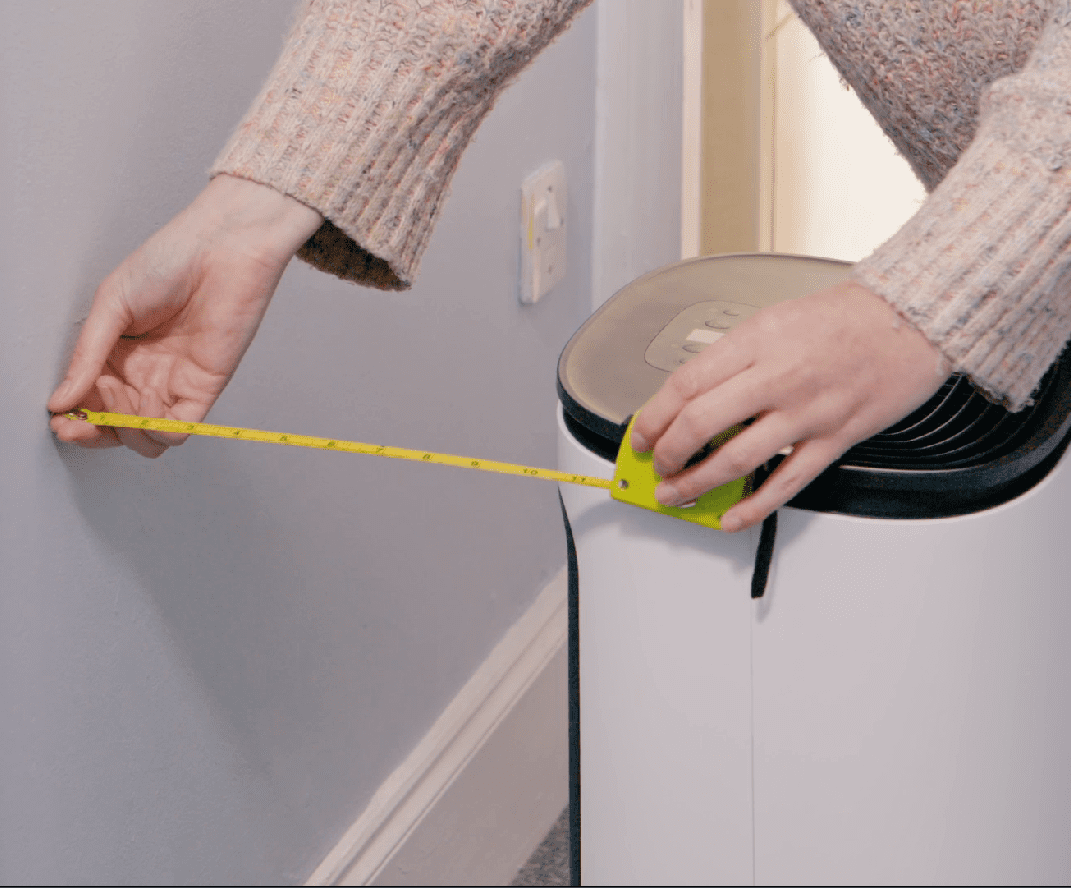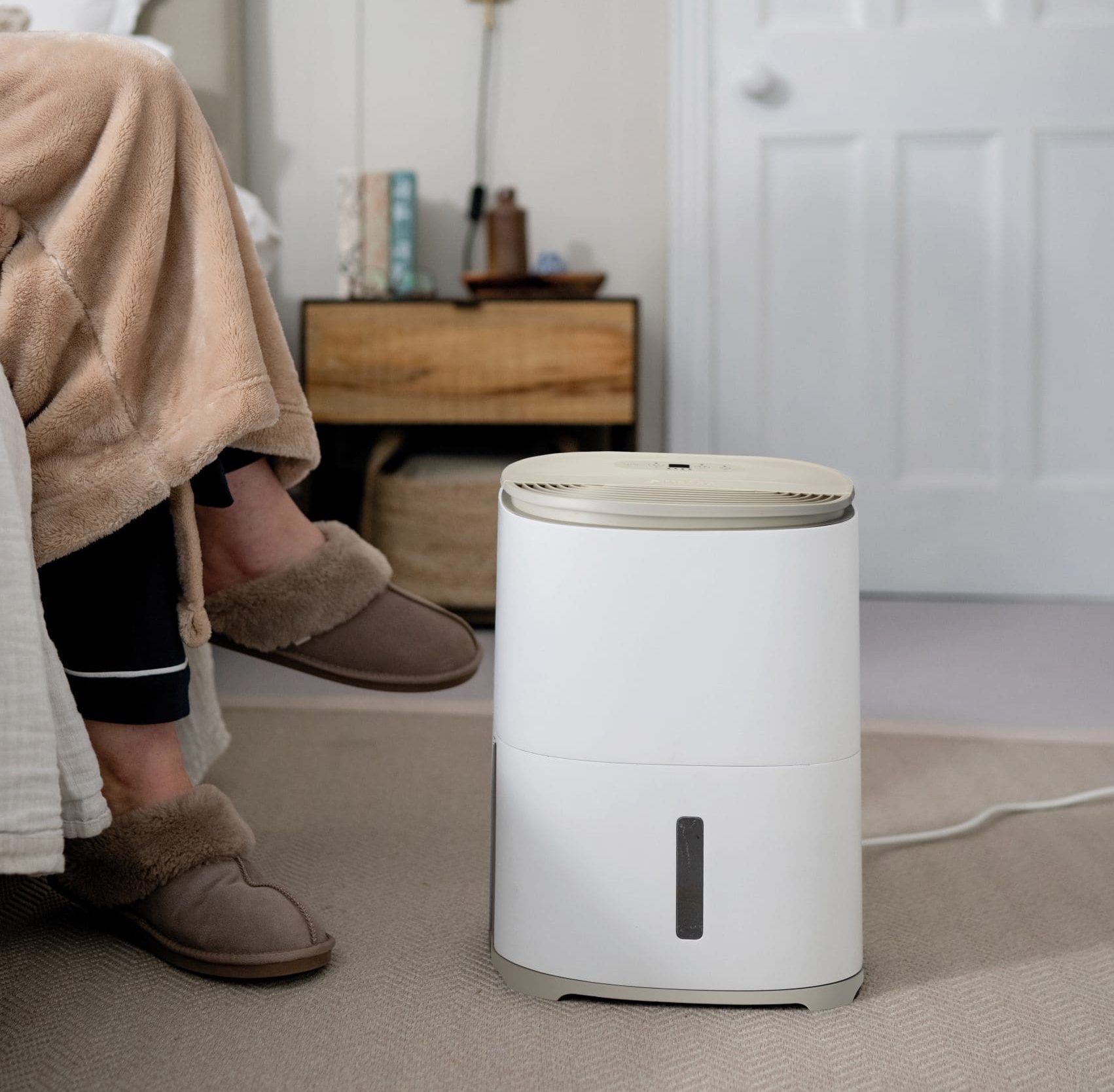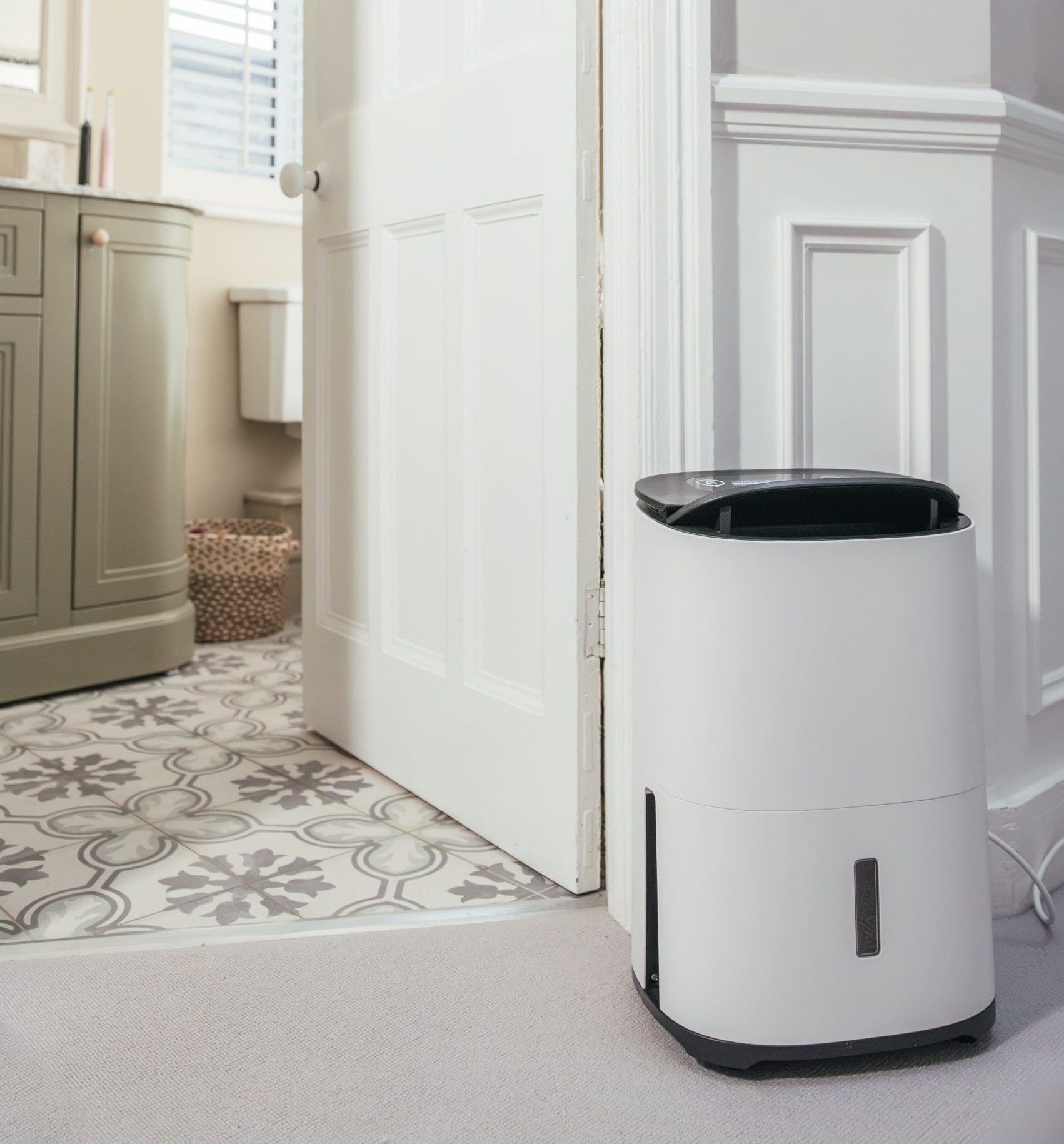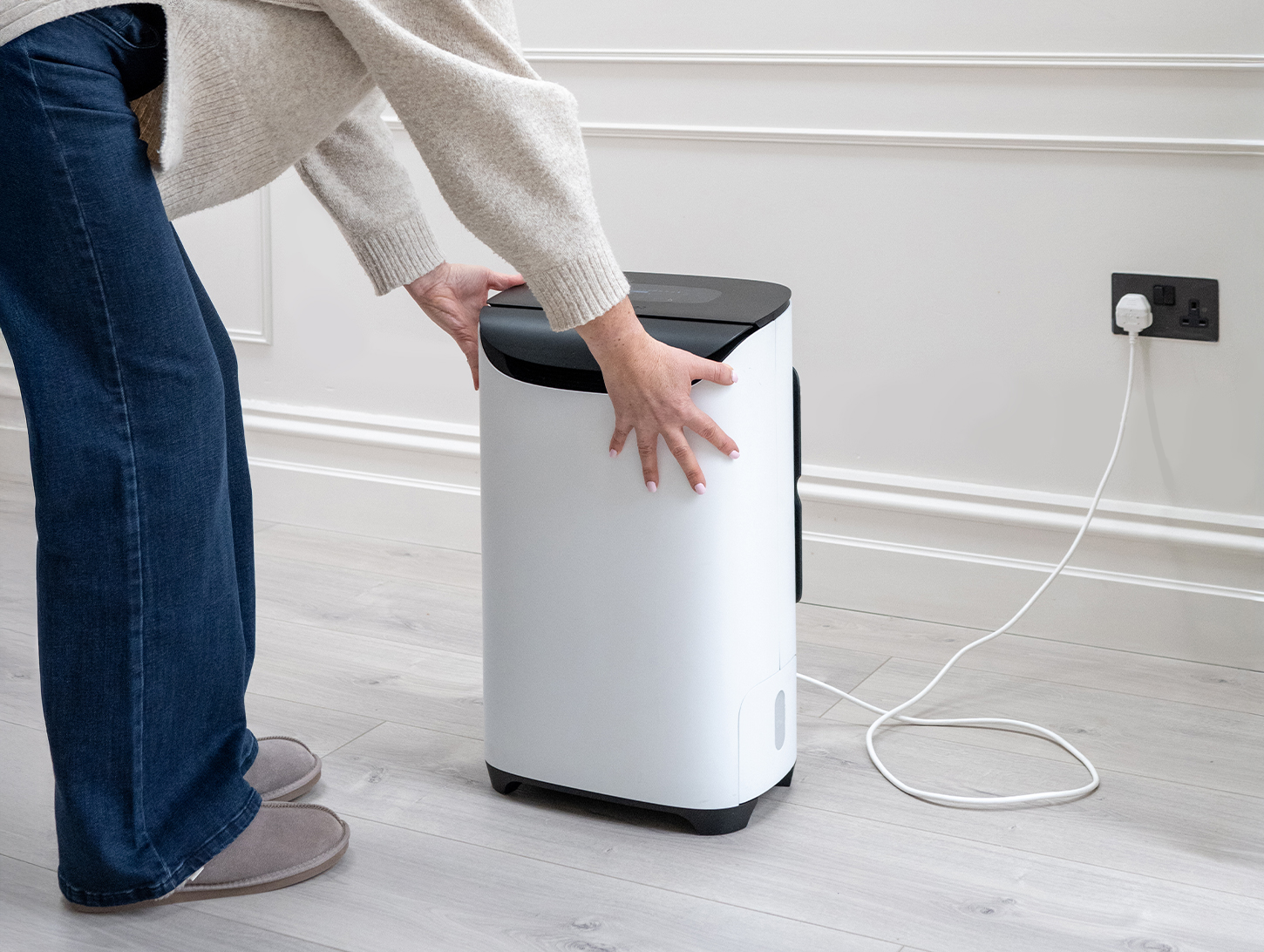Where shall I place my dehumidifier around the house?
We get lots of questions asking us how to use a dehumidifier and where best to put it around the house. It’s best to place it somewhere central in the house, being sure to think about where your sources of moisture are. Moisture problems like damp and mould are typically likely to arise in the bathroom, where showers and baths create lots of steam. And so, it is best to position your dehumidifier on the landing. Here, the dehumidifier will create a dry spot; and as long as internal doors are kept open, any moisture from the bathroom or anywhere else in the house, will migrate here. The dehumidifier will draw in the moisture, turning it into water.
If the unit is set up in a relatively permanent position and if you do not wish to empty the tank manually, you could set up your dehumidifier with continuous drainage. When using continuous drainage via a hose on its own, the water is drained from the dehumidifier via gravity. This means the hose must go downhill, without any kinks or blockages, to allow the water to flow. Ensure the end of the hose is lower than the drainage port and the water can flow downwards into a sink or drain. Because of this, it can be best to place the dehumidifier on the kitchen side (to give it the height), next to a sink, so the hose can drain the water straight into the sink and down the drain.
If the hose can only go uphill, then you could install a water pump. If you want to learn how to install this, you can watch our YouTube video.
The beauty of Arete®

In general, dehumidifiers need to be about 30 cm away from the wall. And if positioned in a hallway, landing, or a flat or small house, that means it’ll be in the way. Very annoying.
But that’s the beauty of Arete®, as this is the only dehumidifier that solves that problem. Designed here in the UK, this machine has been made with British and European customers in mind. We know that you’ll probably place your dehumidifier in a landing or a hallway, so we have worked hard to engineer an appliance that doesn’t take up unnecessary space and becomes a nuisance to own. With Arete®, you can put it right up against the wall, and it will still do the job.
The MeacoDry Arete® 6L – small, whisper-quiet and perfect for compact spaces
The newest addition to the Arete® range, the 6L model is designed for those who want all the benefits of Arete® in a smaller, lighter and even quieter package. Small enough to fit seamlessly into your space, it’s powerful enough to make a real difference in rooms up to 25m².
The Arete® One 6L works as both a compact dehumidifier and air purifier, making it ideal for tackling damp, mould and condensation where space is limited. Despite its compact footprint, it still delivers the same user-friendly controls, low noise levels and excellent humidity performance that define the rest of the Arete® range.
Like all Arete® models, it can be placed flush against a wall – a huge advantage when every centimetre counts. Quiet, efficient and easy to live with, it offers practical features such as laundry-drying modes, making it a discreet yet effective solution for everyday moisture and mild damp issues.

What target relative humidity should we set our dehumidifier to?
The optimum humidity for UK homes is between 50%rh and 55%rh. This is dry enough to remove condensation and prevent damp and mould issues, but not too dry that it would cause other issues such as dry, itchy skin and sore throats.
In colder months, some people may find this target isn’t low enough to reduce condensation on their windows. In these circumstances, the target humidity for your dehumidifier to reach can be reduced to around 40%rh.
But in general terms, aim for 55%rh. That’s what museums use when they’re looking after their collections; so, if it’s good enough for museums, it’s good enough for us.
With Meaco Control Logic, your Meaco dehumidifier has been engineered to maintain a steady and comfortable humidity level with maximum energy efficiency. It automatically adjusts fan speed based on the gap between the target and current humidity, reducing power consumption without compromising performance. Once the desired humidity is reached, let’s say 55%RH, the dehumidifier switches off and monitors the air every 30 minutes, only restarting if humidity rises by more than 5 percent. This smart control ensures low running costs and consistent air quality, keeping your space comfortable and energy-wise.
Can I move my dehumidifier from room to room?
You can. However, it is best to keep your dehumidifier in one place. This is because the dehumidifier brings moisture towards itself, creating a dry spot in the process. Let it do the job by leaving it in one place, and leaving all internal doors open. Get used to bringing the laundry to the dehumidifier, rather than moving the dehumidifier to the laundry.

What about the filter?
The dust filter is very important as it stops dust and dirt from getting into the machine. It is extremely important to clean the filter on a regular basis. Without regular cleaning, dirt and dust will build up over time and stop air passing through it. When the air can’t pass through it, the machine starts to use more energy, so your electricity bill will go up. It will also cause the machine to make more noise. So it’s in your vested interest just to keep the filter clean.
If you’ve got a HEPA filter, when it turns from white to dark gray, it’s ready to be disposed of in the general waste. It may not sound very environmentally friendly, but the filter collects all sorts of bacteria, which no one wants entering the recycling system. To deal with it correctly, it’s best to dispose of it in the general waste.
Save money on your heating bill with a dehumidifier
Having a dehumidifier in the home turns all damp air into dry air, which is makes it far easier for your central heating system to heat your home. This is because all of the extra moisture in the air needs to be warmed up before you can start to feel warm.
A dehumidifier keeps the relative humidity in the house at a sensible level. It’s not too dry that it will cause you any problems, but at a level where you won’t get issues of damp mold and condensation and one that makes your heating system more energy efficient.
With a dehumidifier, you’ll start turning down your thermostat, and you’ll save money on your heating bill. Yet another benefit that comes from owning a dehumidifier.
We’d love to hear your ideas and questions, so please feel free to share them with us by leaving a message in the comment section below.
Products featured:







125 responses
Hi, can you put the central heating on, while the dehumidifier is on thank you
Abaid,
Thank you for your enquiry.
Yes, you can use the central heating at the same time as the dehumidifier. In fact, compressor dehumidifiers work better in warmer air, so having the heating on can help it remove moisture more efficiently.
KR,
Omar@Meaco
House, two floors the upper floor has 3 bedrooms and bathroom, the ground floor has room and kitchen and bathroom with bad ventilation from kitchen
Which capacity and type do I need
Hasan,
Thank you for your enquiry.
Based on your house having two floors, 3 bedrooms and poor kitchen ventilation, I’d recommend a 20L capacity dehumidifier such as any of those in the Arete range. That size gives you enough moisture removal for larger spaces and areas with ventilation issues, helping keep the whole home drier and more comfortable.
KR,
Omar@Meaco
I would like to comment on how great my Arête one 25l is about 2 years old so I no longer use tumble dryer for my clothes and damp no mildew anywhere in my 2 bedroom flat windows stay dry any time of year please anyone thinking about this machine nothing compares with arête believe me I’ve used other brands nothing compares to Meaco at all very pleased customer
Jeff,
Thank you for taking the time to share your experience. We’re really pleased to hear how well your Arete dehumidifier has been performing over the years.
Using a dehumidifier instead of a tumble dryer is a great choice. Drying clothes with a dehumidifier uses far less energy, avoids heat damage, and is much gentler on fabrics, helping clothes last longer. At the same time, the moisture removed from laundry is captured before it can settle on walls, windows, or furniture.
It’s also great to hear the wider benefits in your home such as the dry windows, no damp, and no mildew, exactly what the Arete is designed to achieve. A good dehumidifier isn’t just for laundry; it improves air quality and helps protect the whole home all year round.
Thank you again for your kind words and recommendation. We’re delighted to have you as a very pleased Meaco customer.
Kind regards,
Omar@Meaco
Wondering what capacity unit to get. Two adults, two teens in a 2 bed flat. Laundry is currently dried in the main living area/open plan kitchen. Bathroom is at opposite end of the flat but gets terrible condensation (extractor fan not really up to the job) and is windowless. What would you suggest?
Sarah,
Thank you for your message. For a 2 bed flat with four people, a lot of laundry, and a bathroom with poor ventilation, a 12L dehumidifier would work, but for the best and most effective performance we would recommend the Arete Two 20L. It will cope better with the high moisture levels from laundry and the condensation issues in the bathroom, giving you faster results and better control overall.
KR,
Omar
I have just purchased a Areate 12 L Dehumidifier Air Purifier Smart. We have positioned in the main bedroom, where we had problem with windows condensing and mould growing in a corner behind a bedside cabinet. Do I need to leave dehumidifier on permanently?
Graham,
Thank you for your purchase. You don’t need to run it permanently in the sense of “running all day nonstop.”
Set the unit to Smart Humidity at 55% (as outlined in the manual). Once it reaches that level, it will stop itself and only wake up every 30 minutes to check the room conditions. That means it’s monitoring 24/7, not running 24/7 so you get control of condensation and mould without wasting energy.
If the bedroom is the main problem room, leave it there until everything is fully under control. After that, you can try placing it on the landing to benefit the rest of the property.
This setup will keep the humidity at a healthy level and stop the mould from getting worse.
I hope that helps,
Omar@Meaco
Hi I just purchased a 25 litre arete two.i can’t turn it on because it’s saying I have to scan this code and ad an app.
As I don’t do technology and just want to plug in and go can this be used without the app.
Many thanks.
Gail,
Thank you for your purchase. You don’t need the app at all, the Arete Two works perfectly as a normal plug-in-and-go dehumidifier.
The WiFi feature is optional. If you don’t want to use it, just keep to using the control panel on the unit.
All the key functions are available directly on the machine, so you’re completely fine to run it without any App/WiFi setup.
I hope that helps,
Omar@Meaco
I live in a two bedroom small house, north facing, very difficult to heat. Condensation is dreadful, despite good air circulation. I need to tackle this, but at the same time dry the laundry. I was considering the 10L or the12L. Then perhaps to buy one just for use in the kitchen to dry laundry. Then keep one on the landing. Confused. Can’t decide.
Isabelle,
Thanks for your message. For a two-bedroom house, a 10L dehumidifier is usually sufficient, but if condensation is particularly bad, you might want to consider the 12L for extra capacity. The Arete models handle laundry drying easily with their dedicated Laundry Mode, so one unit can often do both tasks.
Since it can be a bit confusing to decide which size and placement will work best for your home, we recommend giving our team a call to help you decide.
KR,
Omar@Meaco
Hi! I live in a 5 bed (2000sq ft) victorian house which has 3 floors. I’ve bought the 25l arete two. Wheres the best location to put this so that my entire house is covered? Ideally I’d like to put it in the utility room where the washing machine and tumble dryer are but that’s on the ground floor at the back of the house. Would it make much sense there or is it best to put it centrally, ie first floor hallway?
Chris,
Thank you for your purchase. You’re on the right track. For the best overall coverage, it’s ideal to place your dehumidifier centrally, such as in the first-floor hallway, so the dehumidified air can reach all areas more evenly. You can then relocate it to the utility room when you specifically need to tackle laundry moisture from the washing machine and tumble dryer.
KR,
Omar@Meaco
Hi, I have a Meaco 20L Low Energy Dehumidifier and Air Purifier.
I don’t use a hepa filter as I understand that stops the dehumidifier working to full potential. I have one in my office at work and it works brilliantly overnight getting the condensation off the front of our building in my room and reception (all glass windows).
The back of the office is basically a prefab shed with a tin roof. The condensation between the polystyrene ceiling tiles and the tin roof gets really bad and has in the past leaked causing issues with the electrics.
I’ve just purchased a second unit to have in that part of the building. Would it be enough to just turn it on, or would I need to remove some ceiling tile so the water can get sucked down? If I do, would I need to just remove on in each section? There is a hall way and then a main part, which the kitchen and toilet are off of? Thank you
Emma,
Thank you for your enquiry. A dehumidifier can only work with the air it has access to, so if the moisture is trapped above the tiles, the unit simply won’t be able to reach it. If you physically open tiles, you could create large cold bridges and bring in fresh moisture from the roof area, which usually makes things worse, not better.
Keep in mind that for any dehumidifier to work properly, the space needs to be relatively well sealed with no fresh air constantly entering, also avoid any situations where water could drip directly into the appliance.
Any questions, give us a call.
Hope that helps,
Omar@Meaco